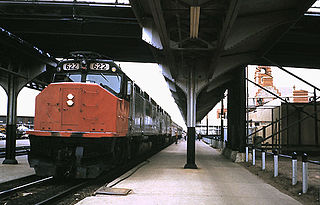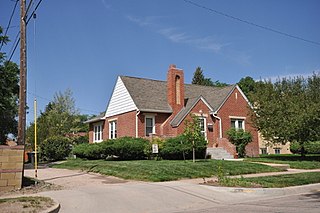
The Wyoming State Capitol is the state capitol and seat of government of the U.S. state of Wyoming. Built between 1886 and 1890, the capitol is located in Cheyenne and contains the chambers of the Wyoming State Legislature as well as the office of the Governor of Wyoming. It was designated a U.S. National Historic Landmark in 1987. The Capitol underwent an extensive three-year renovation and reopened to the public on July 10, 2019.

This is a directory of properties and districts listed on the National Register of Historic Places in Wyoming. There are more than 500 listed sites in Wyoming. Each of the 23 counties in Wyoming has at least four listings on the National Register.

The Cheyenne Depot Museum is a railroad museum in Cheyenne, Wyoming, United States. It is located inside the 1880s Union Pacific Railroad depot. A National Historic Landmark, the station was the railroad's largest west of Council Bluffs, Iowa, and a major western example of Richardsonian Romanesque architecture.
The Wyoming Governor's Mansion is the official residence of the governor of Wyoming. The current mansion was built during 1976 in Cheyenne.

The Elmer Hess House is a historic residence in the city of Wyoming, Ohio, United States. Erected in the late nineteenth century, it was originally the home of a Cincinnati industrialist, and it has been designated a historic site because of its distinctive architecture.

The Charles H. Moore House is a historic residence in the city of Wyoming, Ohio, United States. Built in 1910 and home for a short time to a leading oilman, it has been designated a historic site.

The Louis Sawyer House is a historic residence in the city of Wyoming, Ohio, United States. Erected at the turn of the twentieth century, it was originally the home of an important lawyer, and it has been designated a historic site because of its architecture.
Lakeview Historic District may refer to:

The Rawhide Buttes Stage Station, the Running Water Stage Station and the Cheyenne–Black Hills Stage Route comprise a historic district that commemorates the stage coach route between Cheyenne, Wyoming, and Deadwood, South Dakota. The route operated beginning in 1876, during the height of the Black Hills Gold Rush, and was replaced in 1887 by a railroad.

The William Sturgis House was built by cattle baron William Sturgis in Cheyenne, Wyoming in 1884. The Shingle Style house was designed by architect George D. Rainsford, a New York architect who moved to Wyoming to raise Morgan horses and Clydesdales. While horse breeding was his principal occupation, Rainsford continued to practice architecture, designing many of the houses in the neighborhood surrounding the Sturgis residence.

The Rainsford Historic District in Cheyenne, Wyoming comprises a group of Victorian houses, many designed by architect George D. Rainsford. The neighborhood includes the residences of a number of cattle barons, giving rise to the name "Cattle Baron Row." The district is located immediately to the east of downtown Cheyenne and includes examples of Stick, Eastlake, Greek Revival, Romanesque Revival and Shingle style architecture, among other eclectic styles of the time. The neighborhood includes the former Wyoming Governor's Mansion and the William Sturgis House, both individually listed on the National Register of Historic Places.

William Dubois (1879–1953) was an American architect and politician. He was a prolific architect in Wyoming and nearby states, and served five terms in both houses of the Wyoming Legislature.
Frederic Hutchinson "Bunk" Porter, Sr., sometimes referred to as Frederick Hutchinson Porter, was an American architect based in Cheyenne, Wyoming. He was active from 1911 to approximately 1965. He designed many of Cheyenne's most important public and commercial buildings and also designed several buildings at the University of Wyoming, including War Memorial Stadium and the Agriculture Building. A number of his works are listed on the U.S. National Register of Historic Places.

The Atlas Theatre, also known as the Atlas Building, at 213 W. 16th St. in Cheyenne, Wyoming, was dating from 1887 and was built out as a theatre in 1908. It was listed on the National Register of Historic Places in 1973.

The Downtown Cheyenne Historic District in Cheyenne, Wyoming is a historic district that was listed on the National Register of Historic Places in 1978. It is an area of about seven blocks, in the core of the original business district of Cheyenne, and home of many of the first masonry commercial buildings in Cheyenne.

The Capitol North Historic District in Cheyenne, Wyoming is a 20.4 acres (8.3 ha) historic district which was listed on the National Register of Historic Places in 1980.

The Cheyenne High School at 2810 House Avenue in Cheyenne, Wyoming is a Late Gothic Revival-style building which was built in 1921. It has also been known as Central High School and as Laramie County School District No.1 Administration Building and was listed on the National Register of Historic Places in 2005.

The University Neighborhood Historic District comprises the residential area south of the University of Wyoming in Laramie, Wyoming. The 24-block historic district is bounded on the north by University Avenue, the east by 15th Street, the south by Custer Street, and the west by 6th Street. The neighborhood's period of significance is from 1872 to 1958, a time when the area around the university was developed. Architectural styles in the district are diverse and the neighborhood is almost entirely composed of single-family residences.

The Hebard Public School, at 413 Seymour Ave. in Cheyenne, Wyoming, was built in 1945. It was listed on the National Register of Historic Places in 2005.

The Moore Haven Heights Historic District, in Cheyenne, Wyoming, is a 100 acres (40 ha) historic district which was listed on the National Register of Historic Places in 2009. The listing included 445 contributing buildings.



















